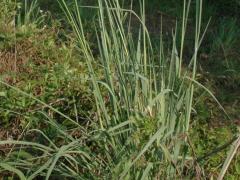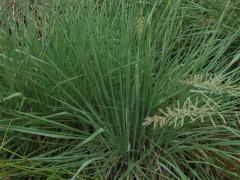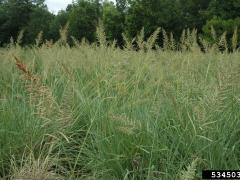Invasive Species: Paspalum quadrifarium, Tussock Paspalum
Tussock paspalum is an invasive perennial plant that grows in large, bluish-green bunches, or tufts, reaching 6 ft. (1.8 m) in height. Leaves are 5.9-15.7 in. (15-40 cm) long, 0.2-0.3 in. (5-8 mm) wide and glabrous. Leaf sheaths are keeled. Tussock paspalum flowers and produces seeds at least twice a year. Flowers are produced in 15-25, 2.4-3.1 in. (6-8 cm) long racemes per plant. Tussock paspalum is found in neglected areas along roadsides, streams, wetlands, and drains. The plant can spread rapidly through rhizomes or seeds and aggressively forms extremely dense infestations in a few years. The small, hard coated seeds range from silver-green to tan in color. Rhizomes move horizontally, sending up suckers, which form large, dense tufts. Native to Uruguay, Paraguay, Brazil, and Argentina, tussock paspalum is used as an ornamental in Florida and has naturalized in Dade County. It can now be found in Georgia and other disturbed habitats of the southeastern United States. Tussock paspalum is considered a noxious weed in Australia and is invasive in Italy and Africa.
What are invasive species and why should we be concerned about them?
Taxonomy: Scientific and Common Names for This Species
Cyperales > Poaceae > Paspalum quadrifarium Lam.
Paspalum quadrifarium – USDA PLANTS Profile
Distribution Maps
Tussock paspalum – The reported distribution of this invasive species across the United States (Source: Invasive Plant Atlas of the United States)
Up-to-the-minute distribution maps and why they are important
Reporting This Invasive Species
What is the best way and place to report the occurrence of an invasive species?
How to report an invasive species sighting to EDDMapS – Early Detection & Distribution Mapping System
EDDMapS – Report an invasive species to EDDMapS.
Cooperarive Extension Offices – Find your local Cooperative Extension office on this map provided by USDA.
How to Identify
This invasive species can be identified by looking for the characteristics described in the paragraphs that follow.
Grass
This grass grows in large, bluish-green bunches, or tufts, reaching 6 ft. (1.8 m) in height.
 |
 |
| Chris Evans, River to River CWMA, bugwood.org | David J. Moorhead, University of Georgia, bugwood.org |
Foliage
Leaves are 5.9-15.7 in. (15-40 cm) long, 0.2-0.3 in. (5-8 mm) wide and glabrous. Leaf sheaths are keeled.
 |
 |
| Chris Evans, River to River CWMA, bugwood.org | David J. Moorhead, University of Georgia, bugwood.org |
Flower
Tussock paspalum flowers and produces seeds at least twice a year. Flowers are produced in 15-25, 2.4-3.1 in. (6-8 cm) long racemes per plant.
 |
 |
| Chris Evans, River to River CWMA, bugwood.org | Chris Evans, River to River CWMA, bugwood.org |
Fruit
The plant can spread rapidly through rhizomes or seeds. The small hard coated seeds range from silver-green to tan in color.
 |
 |
| Chuck Bargeron, University of Georgia, bugwood.org | David J. Moorhead, University of Georgia, bugwood.org |
Native Species That Can Resemble Tussock Paspalum
– Images at invasive.org
| bugwood.org | bugwood.org |
– Images at invasive.org
| bugwood.org | bugwood.org |
Additional Images for Tussock Paspalum
Tussock paspalum – Images at Invasive.org
Additional Information, Biology, Control and Management Resources
Control and management recommendations vary according to individual circumstances. Location, habitat, weather, and a variety of other conditions are factors that help determine the best treatment choice. To find the safest and most effective treatment for your situation, consult your state’s land-grant institution. If you will use chemicals as part of the control process, always refer to the product label.
United States Land-Grant University System – Find your land-grant university’s college of agriculture, Cooperative Extension office, or other related partner on this map provided by USDA.
Environment, Weeds – Pittwater Council, NSW, Australia
Invasive Alien Plant Alert – South African National Biodiversity Institute (SANBI)
